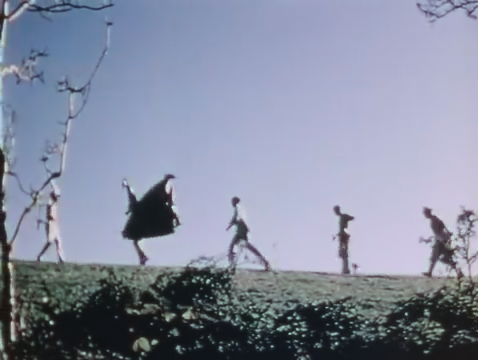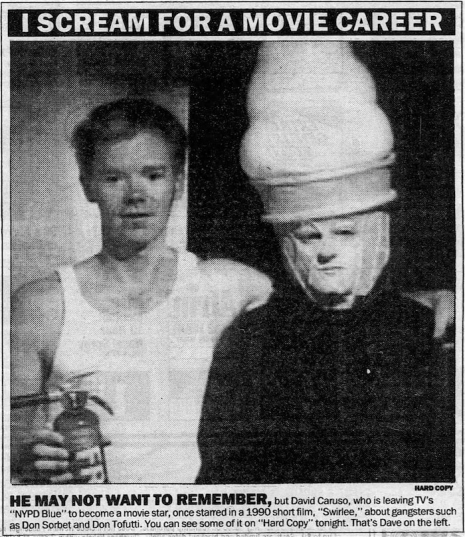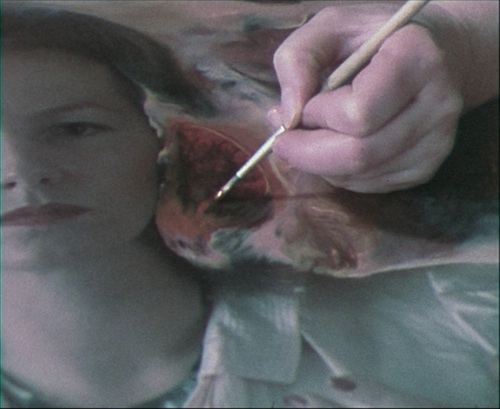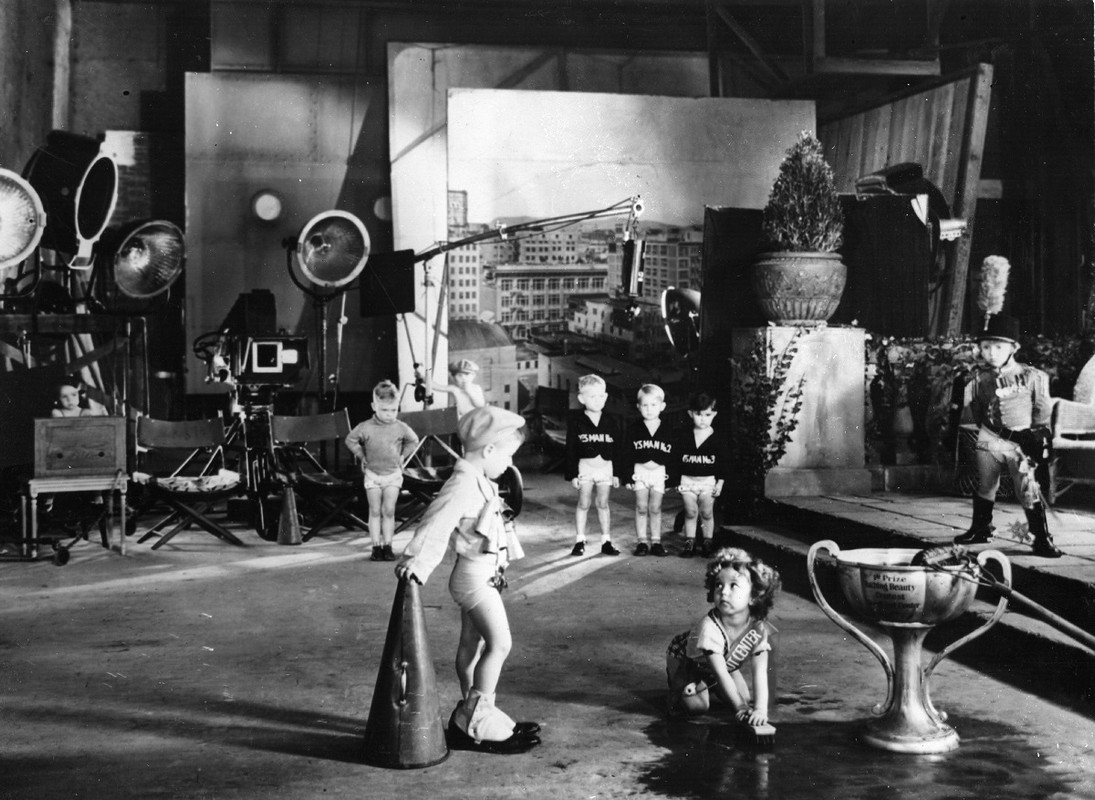“Unite and unite and let us all unite,
For summer is a-come unto day,
And whither we are going we will all unite,
In the merry morning of May.” “Now fare you well and bid you all good cheer,
For summer is acome unto day,
We call no more unto your house before another year,
In the merry morning of May.”Oss Oss Wee Oss (Alan Lomax, 1953)
Aug
22
Folklore Day

The childrens' 'Obby 'Oss May Day procession that precedes the adults' one on a Padstow hillside. DP: George Pickow.
On May 1 – in Padstow, Cornwall – an ancient procession goes around town. How ancient, no one really knows. Locals may describe it as a pagan fertility rite but even their generational memory draws a blank and no living soul can put an age on it. Ancient is what is it, drawing from primitive recollections of maidens and the effigy of a horse. The horse, the 'Obby 'Oss, starts its procession on May Eve, when it rises from its death. Locals gather to sing the “Night Song” and overnight, Padstow is dressed in flowers and a maypole has risen.
– Padstow May Night Song (traditional)
Then the “Morning Song”. Two 'Osses appear, dancing their dance, who then eventually on the evening of May Day meet at the maypole where they die, to be risen again next year.
– Padstow May Day Song (traditional)
Alan Lomax's Oss Oss Wee Oss is probably the best known visual documentation of the Padstow 'Obby 'Oss festival. That it was filmed in 1953 doesn't matter; the ritual is circular, like the horses themselves and the eternal coming and going of the seasons.
shortfilm
“Love your neighbour”Neighbours (Norman McLaren, 1952)
Aug
17
Neighbor Night

Neighbour on the Left (Jean Paul Ladouceur) and Neighbour on the Right (Grant Munro) upon discovering a small flower growing right on their properties' border. Two colourful, almost identical deckchairs can be seen on the lawn in the front and two cardboard façades of almost identical houses in the back. Both men wear almost identical beige slacks and blue shirts and sport a very similar hairstyle. DP: Wolf Koenig.
Norman McLaren's low-budget pixelation (animation created with live action footage) was groundbreaking in many aspects; even the soundtrack was painted directly onto the film stock.
– title card
Read more about its fascinating backstory and watch the short animation over at the National Film Board of Canada's website.
“You and I may dream of gold or grocery bills — but when a child slaps Morpheus on the back and says 'Hello, old man' — well it's a different story.”Moonland (William A. O'Connor, 1926)
Aug
15
Chant At The Moon Day

Mickey (Mickey McBan) and his dog looking up to the crescent moon from a perfectly round window with beaded curtains made of stars. Spot the Milky Way! DP: Edward Gheller.
A little boy and his dog are invited over by the Man in the Moon himself. The trip to the Moon is a big adventure for the drowsy duo and they meet peculiar flora, fauna and men along the way, lifted straight from the Great Moon Hoax.
– opening title card
Post-McCay's serial Little Nemo in Slumberland (1905) and pre-Fleming & Cukor's The Wizard of Oz (1939), William A. O'Connor is heavily indebted to both. Which doesn't make his short Art Deco-styled science fiction fantasy any less magical.
His Wife's Mistakes (Roscoe Arbuckle, 1916)
Aug
4
National Water Balloon Day

Janitor Roscoe uses the comedy staple seltzer bottle to fill a balloon with some spritz!
The great Roscoe Arbuckle just can't help himself at the wonderfully hedonistic Oriental Café in this delightful short slapstick.
Moć [Power] (Vlatko Gilić, 1973)
Jul
25
Threading The Needle Day

One of the men, threading the needle. He's young, bearded, and shirtless and in what appears to be a cave or cellar. DP: Ljubomir Ivković.
Slobodan Ćirković aka Roko was (or is? I cannot find a lot of information online) a Serbian hypnotist capable of making people painlessly self-inflict torment. In Vlatko Gilić's short and rather disturbing Moć, Roko initiates a large group of men to thread a needle and slowly, going from him to the next to the other, connect the one thread through their bodies until all of them are stitched into one.
Strangely homoerotic and determinately violent, Moć feels deeply rooted in the #Serbian psyche. There's beauty and an unflinching élan-vital under the skin, a tenderness that comes with great, unmentionable #pain, love and death.
Swirlee (James Lorinz, 1989)
Jul
23
National Vanilla Ice Cream Day

Newspaper clipping. Mr Softy's roommate (David Caruso) and Mr Softy (James Lorinz), a man with a softee for/as a head, pose for a picture.
“Salt, pepper, sugar, ketchup and napkins, New York.” 66 scener fra Amerika [66 Scenes from America] (Jørgen Leth, 1982)
Jul
4
Independence Day

Director Jørgen Leth capturing Tsé Biiʼ Ndzisgaii [Merrick Butte] in Monument Valley, AZ, for the opening scene. He's waving a small American flag in front of the camera. DP: Dan Holmberg.
A road movie becomes interesting when the traveller is a stranger. When he or she takes that first step, head still firmly planted at home, soul on its way out.
Jørgen Leth is a Danish documentary maker who in the early 80s sent sixty-six postcards from America. These postcards form a #travelogue of bewilderment. The #landscape, #food, language, anything an American may take for granted framed in a moving still. The American, ever ready for stardom, poses and orates. The scenes become show, regardless if it's a New York cabbie or a man famously (falsely) credited for predicting fame, slowly eating a Whopper.
The resulting 66 scener fra Amerika is as much a time capsule as it is a portrait of forever.
“An diesem Tag war das Bild, drei Monate nach Beginn und 67 Arbeitstagen fertig.”Ein Bild von Sarah Schumann [A Picture of Sarah Schumann] (Harun Farocki, 1978)
Jun
26
National Sarah Day

A close-up of the artist's hand at work. More stills and details about this film on Frieze. DP: Ingo Kratisch.
Commissioned for a West-German TV series called Kunstgeschichten (litt. both “art stories” and “#art histories”), filmmaker Harun Farocki visits artist Sarah Schumann in her #Berlin studio.
– narrator
The resulting documentary shows the process of creating one art piece over the course of nine weeks. Schumann's work in that period consists of collage portraits of women important in her life.
“Tire dié!”Tire dié [Toss Me a Dime] (Fernando Birri, 1958)
Jun
20
National Flag Day – Argentina

A young boy running along the train. Another, even younger, child can be just seen behind him. DPs: Oscar Kopp & Enrique Urteaga.
A slum survives next to a railroad bridge. When the train travelling from the city shows up, the children who are old and gutsy enough run along and yell tire dié! toss me a dime! Some of them make more than their parents do.
Tire dié is a sobering account of #poverty and how it's as much a part of life's schedule as a slow running train on a rickety bridge.
“This isn’t playtime, kids, it’s work.” “Any star can be devoured by human adoration, sparkle by sparkle.”Kid 'N' Hollywood [Kid in Hollywood] (Charles Lamont, 1933)
Jun
12
Child Labor Day

A movie set on a movie set in Kid 'N' Hollywood. Shirley Temple can be seen on her knees scrubbing the floor as the character Morelegs Sweettrick. Standing next to her with a bullhorn and adult spats is Arthur J. Maskery as the tyrannical movie director Frightwig von Stumblebum. As in all the Baby Burlesk shorts, the kids are only half-dressed with their diapers showing.
Despite Shirley Temple's clear statements of what was going on on set during her child actress days, her output remains wildly popular. Who cannot resist her precocious lines, her cute dimples and baby doll innocence? And tapdancing with ánd befriending a Negro, during the segregation years? Miss Shirley truly was wise beyond her tender age.
Shirley Temple was “discovered” at the age of three by then-casting director Charles Lamont and promptly shot to stardom is his satirical Baby Burlesks: short talkies starring toddlers in diapers (a burlesque being a short, humorous skit). The gag was that the kids behaved and spoke like adults, seemingly unaware of being #children.
– Charles Lamont, Baby Burlesk director
In the Baby Burlesk Kid 'N' Hollywood, Temple plays a Hollywood hopeful called Morelegs Sweettrick, who gets her break when the star doesn't feel like showing up (kids, right? no discipline).
While Kid 'N' Hollywood is relatively innocent, others in the series are much more sexualised (War Babies (1932) stars Temple as prostitute Charmaine) or plain racist (Kid 'in' Africa (1933) with Temple as Madame Cradlebait, bringing civilisation to Black kids portraying fearsome cannibals).
I'm not the one to take events from the past out of context and apply modern-day sensibilities to them, and with the advent of #ChildLabor laws for #Hollywood child actors, many of the horrors recalled by Temple and her peers are history. School is mandatory, long hours restricted, and using twins to split the workload is definitely not unheard of.
And then I watched teevee, and saw chubby, precocious blondes with dental plates to hide their missing baby teeth, wearing lipstick and baby-dolls, grinding and crooning with no backup in sight. And I remember Miss Temple say:
– Shirley Temple